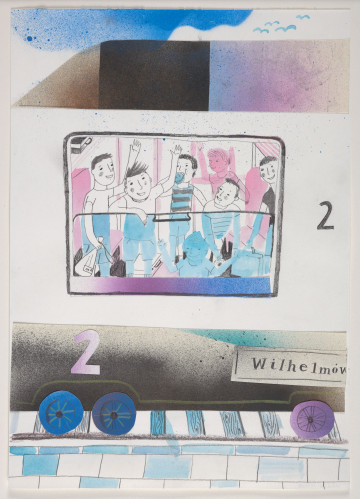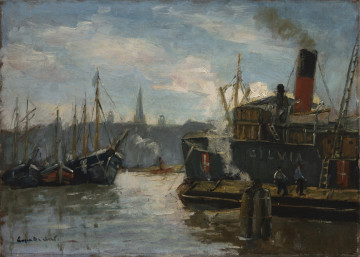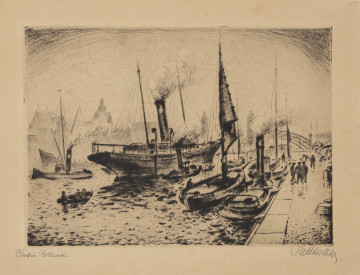
Journey
1. ćwierć XXI wieku
Museum of the history of Polish Jews
Part of the collection: Iconography of Szczecin 1900-1945
At the turn of the 19th and 20th centuries, one can notice a tendency to realistic and faithful representation of reality in the works of artists working in Szczecin. City architecture, ancient single tenement houses or their groups, constituted an interesting painting subject, reaching back to the canons of Romanticism. An example of this trend is Albin Neubauer's work from 1918 depicting the Monin tenement house (Moninsche Haus) at 4 Sienny Market Square. Neubauer was a technician, merchant and draftsman working in Szczecin and from 1942 in Podjuchy (today a right-bank district of the city). He depicted the Monin tenement house and a fragment of the neighbouring building with great accuracy, confirmed by photographs from around 1925. The tenement, drawn with a dense net of trim lines, was shown from the perspective of a person seeing it from the window of a building on the neighbouring frontage of the Sienny Rynek (Heumarkt). Sienny Rynek was a market square where hay trading had taken place since the Middle Ages. It was destroyed during the Swedish-Brandenburg War (1674-1679) and rebuilt at the turn of the 17th - 18th centuries. The facades of burgher houses, including the Monin tenement house, were then given impressively decorated baroque forms modelled on the buildings of Dutch cities, especially Amsterdam. The tenement was conceived as a place for trade in exclusive overseas goods. On the façade, between the rows of windows on the first and second floors, there were four oval fields with representations of the continents and their names: Europe, Asia, Africa and America. The first owner was the goldsmith Tutsberg, and from 1721 a Springer. The building owes its name to its later owners, the Monin family, who used it from the second half of the 19th century until 1919, rebuilding the ground floor for their colonial shop. After the First World War, the building's new user was Franz Materna, the owner of a carpentry company. The Second World War did not spare the building, which burned down like most others in the area. It was rebuilt in the 1990s, referring to the original baroque style.
Małgorzata Peszko
Author / creator
Dimensions
cały obiekt: height: 26,5 cm, width: 21,5 cm
Object type
drawing
Creation time / dating
Creation / finding place
Identification number
Location / status

1. ćwierć XXI wieku
Museum of the history of Polish Jews

około 1930
National Museum in Szczecin

1920 — 1935
National Museum in Szczecin
DISCOVER this TOPIC
National Museum in Szczecin
DISCOVER this PATH
Educational path